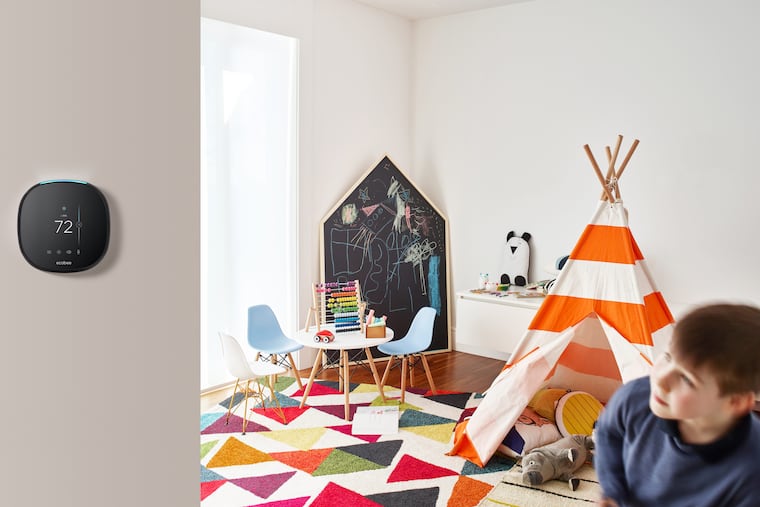How mastering your thermostat could save you a bundle this winter
According to the EPA, proper use of a programmable thermostat helps the average household save about $180 a year in energy costs.

Want to trim your heating costs this winter? Learning how to effectively use your house's thermostat can help you slash those utility bills.
The average household spends roughly $2,000 a year on energy bills, according to Energy Star, an efficiency program managed by the Environmental Protection Agency and the Energy Department. Nearly one-third of that money goes to heating costs.
Though steps such as sealing air leaks and changing furnace filters can help you conserve energy, knowing how to wield your home's thermostat is one of the best ways to clamp down on the costs of heating, which the U.S. Energy Information Administration predicts will slightly increase this winter because of colder weather.
Here's what you need to know about thermostats to stay warm this winter without overheating your budget.
Which is right for you?
A manual thermostat is the old-fashioned variety that lets you adjust the temperature in your house by moving a needle or by pressing "up" and "down" buttons. These thermostats — which generally range from $15 to $35, HomeAdvisor.com reports — are common in older homes, and they may be sufficient for people who spend most of their time at home, says Stacey Higginbotham, an Austin-based home technology expert.
But a simple thermostat can be replaced by a programmable or smart thermostat — maybe even by yourself. And if you're not confident in your DIY skills, most manufacturers offer professional installation, though it can be costly. You also can get installation quotes on service websites such as Thumbtack.
A programmable thermostat is essentially a "set-it-and-forget-it" product that lets you control when your home's heating or air-conditioning system turns on according to a preset schedule. According to the EPA, proper use of a programmable thermostat helps the average household save about $180 a year in energy costs. For most homeowners, a programmable thermostat is worth the upfront investment, considering that it only costs about $20 to $150, HomeAdvisor says.
A smart thermostat offers even greater convenience. Typically, these devices enable you to adjust your home's thermostat remotely from an app on your phone. Some can even detect when you're away from your house by tracking your phone's location. "If you're gone, [a smart thermostat] can set the temperature to an energy-saving 'away' setting. Then, when it detects you are back in your home, it will resume the regular temperature setting," says Eric Blank, editor at the Smart Cave, a smart-home product review website. "This can be a big energy saver."
Some smart thermostats will also connect to your home's voice assistant — meaning you can tell Alexa to adjust the heat without leaving your couch.
But, smart thermostats, which cost, on average, $200 to $300 or more, aren't right for everyone.
"I think it depends on the homeowner's habits," Higginbotham says. "The best candidates for smart thermostats are people who leave their house often, since they can raise or lower their heating and cooling as need be."
Naturally, smart thermostats also are better suited for homeowners who are tech-savvy, says Pascale Maslin, owner of Silver Spring-based Energy Efficiency Experts, an energy auditing company. "You need to be able to understand the technology."
Blank agrees. "If you're not a techie, it may end up being more trouble than it's worth. Even with the best products, there's potential for a disconnect problem or a configuration problem. If you end up having to do a service call, the cost of that call will add another year-plus to your payback period."
So, how can you tell whether you're ready to go smart? "I would say a decent litmus test for technological competence would be being able to set up your home's wireless router," Blank says. If you pass that test, you should be able to learn how to operate a smart thermostat without losing your mind, he says.
Maximizing savings
No matter what type of thermostat you have, you should be adjusting your home's temperature before you sleep, Maslin says. Indeed, you can save as much as 10 percent a year on heating and cooling by adjusting your thermostat setting by 7 to 10 degrees from its normal setting for eight hours a day, according to the Energy Department.
If your house has more than one heating or cooling zone, installing a separate thermostat for each system can help you save more money, because some rooms (such as the basement or attic) tend to require more heating or air conditioning than others.
In addition, you'll want to install your thermostat away from heating or cooling registers to ensure it gets an accurate reading. A thermostat placed in the kitchen, for example, could make your device "think" your house is warmer than it truly is.